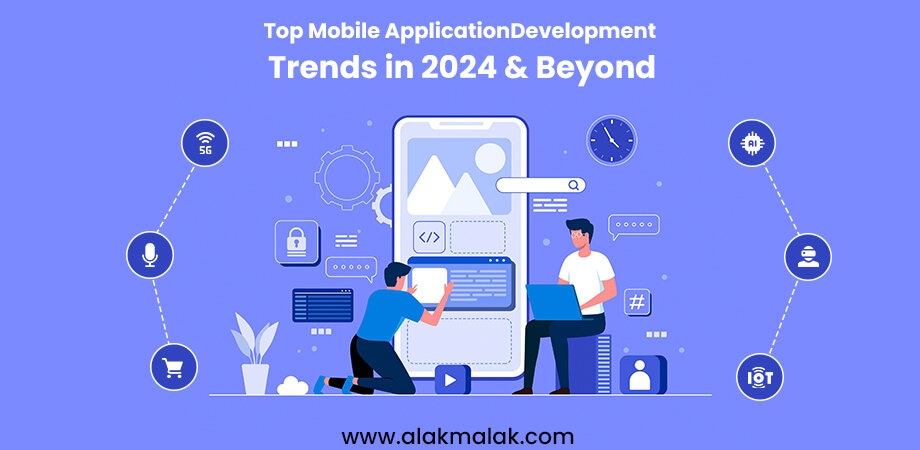Are you an Android app developer looking to stay ahead of the curve? With the constantly evolving technology landscape, it’s crucial to keep up with the latest trends in Android app development. In this blog post, we’ll explore the top trends that are shaping the future of Android app development.
Whether you’re a seasoned developer or just starting out, staying informed about the latest trends can help you create more engaging, efficient, and user-friendly apps. From advancements in artificial intelligence and machine learning to the rise of cross-platform development and the Internet of Things (IoT), there are numerous trends that are transforming the way we build and interact with Android apps.
As an experienced Android app development team with 18 years of expertise, we’ve witnessed firsthand the impact of these trends on the industry. Our team has successfully developed numerous high-performing Android apps for clients across various industries, leveraging the latest technologies and best practices. In this blog post, we’ll share our insights and expertise to help you navigate the top trends in Android app development.
Whether you’re looking to optimize your existing apps or embark on a new project, understanding these trends will empower you to make informed decisions and deliver exceptional user experiences. So, let’s dive in and explore the top trends that are shaping the future of Android app development.
Top Trends for Android App Development
TABLE OF CONTENT
1. Artificial Intelligence and Machine Learning
2. AI-Powered Chatbots
3. Use of 5G
4. Cloud Computing
5. Internet of Things
6. Augmented Reality and Virtual Reality
7. On-Demand Apps
8. Camera-Centric Android Apps
9. Use Android Studio
Tools and Resources
Case Study: Embracing AI and 5G in a Ride-Hailing App
Embrace the Future: Stay Ahead with Cutting-Edge Android App Development
1. Artificial Intelligence and Machine Learning
Artificial Intelligence (AI) and Machine Learning (ML) are rapidly transforming the way we develop and interact with mobile applications. These cutting-edge technologies are revolutionizing the Android app development landscape by enabling advanced features, personalized experiences, and intelligent decision-making capabilities.
Why it is important
Incorporating AI and ML into Android app development offers numerous benefits. According to a report by MarketsandMarkets, the global AI in mobile applications market is expected to grow from $1.9 billion in 2020 to $8.5 billion by 2025, at a CAGR of 35.2% during the forecast period. This staggering growth highlights the increasing demand for intelligent and personalized mobile experiences, making it crucial for developers to embrace these technologies.
How to implement
- Predictive Analytics: Leverage ML algorithms to analyze user data and behavior patterns, enabling your app to make intelligent predictions and provide personalized recommendations, such as suggesting relevant content or products based on user preferences.
- Image and Speech Recognition: Integrate AI-powered image and speech recognition capabilities into your app, allowing users to interact with the app using voice commands or visual inputs for a more natural and intuitive experience.
- Chatbots and Virtual Assistants: Implement conversational AI solutions, like chatbots or virtual assistants, to provide 24/7 customer support, answer user queries, and assist with task automation.
- Intelligent Apps: Utilize ML algorithms to create intelligent apps that can learn and adapt to user behavior over time, providing a more personalized and efficient experience.
Industry Stats:
According to a study by Accenture, companies that have successfully integrated AI and ML into their mobile apps have reported a 17% increase in customer satisfaction and a 12% increase in revenue.
2. AI-Powered Chatbots
Chatbots have become an increasingly popular trend in Android app development, enabling businesses to provide personalized and efficient customer support, automate repetitive tasks, and enhance the overall user experience. With the integration of Artificial Intelligence (AI) and Natural Language Processing (NLP), chatbots have evolved from simple rule-based systems to intelligent conversational agents capable of understanding and responding to complex queries in a more human-like manner.
Why it is important
Implementing AI-powered chatbots in Android apps offers numerous benefits. According to a study by Juniper Research, the global chatbot market is expected to reach $7.8 billion by 2025, driven by the increasing demand for efficient customer service and the growing adoption of conversational AI technologies. Chatbots can significantly improve customer satisfaction, reduce operational costs, and provide 24/7 support, making them a valuable addition to any mobile app.
How to implement
- Choose the right chatbot platform: Evaluate and select a chatbot platform that integrates well with your Android app and offers the necessary AI and NLP capabilities, such as DialogFlow, IBM Watson, or Amazon Lex.
- Define conversation flows: Map out the potential user interactions and design conversation flows that cover common use cases and scenarios, ensuring a natural and intuitive conversational experience.
- Train the chatbot: Utilize NLP algorithms and machine learning techniques to train your chatbot on relevant data, such as customer support logs, product manuals, and frequently asked questions, to improve its understanding and response accuracy.
- Integrate with your app: Seamlessly integrate the chatbot into your Android app, providing users with a consistent and unified experience across different channels (e.g., in-app messaging, voice commands, or dedicated chatbot interface).
Continuously improve: Monitor user interactions, gather feedback, and analyze chatbot performance to identify areas for improvement, refine the conversational flows, and retrain the chatbot as needed.
3. Use of 5G
The advent of 5G technology is set to revolutionize the mobile app development landscape, particularly for Android apps. With its promise of faster data speeds, lower latency, and increased network capacity, 5G has the potential to unlock a whole new realm of possibilities for app developers, paving the way for innovative and immersive experiences.
Why it is important
Embracing 5G technology in Android app development is crucial for several reasons. According to a report by Ericsson, 5G is expected to cover up to 65% of the world’s population by 2025, making it a game-changer for mobile connectivity. Additionally, the higher bandwidth and lower latency offered by 5G will enable real-time data transfer, which is essential for applications that require instantaneous responses, such as augmented reality (AR), virtual reality (VR), and remote control of devices.
How to implement
- Optimize app performance: Leverage the increased speed and low latency of 5G to optimize android app performance, enabling faster loading times, smoother streaming, and more responsive user interfaces.
- Implement AR/VR experiences: Explore the integration of AR and VR features into your Android apps, taking advantage of the low latency and high bandwidth of 5G for seamless and immersive experiences.
- Embrace cloud-based services: Utilize cloud-based services and offload resource-intensive computations to remote servers, as 5G’s high data rates and low latency will enable efficient communication between the app and cloud services.
- Real-time data streaming: Develop applications that can stream and process real-time data, such as live video, IoT sensor data, or location-based services, leveraging the low latency and high throughput of 5G networks.
4. Cloud Computing
Cloud computing has emerged as a game-changer in the world of mobile app development, offering a scalable, secure, and cost-effective solution for Android app developers. By leveraging the power of cloud services, developers can offload resource-intensive tasks, store and access data seamlessly, and optimize app performance, enabling them to create more robust and feature-rich applications.
Why it is important
Integrating cloud computing into Android app development is crucial for several reasons. According to a report by MarketsandMarkets, the global cloud computing market is projected to grow from $445.3 billion in 2021 to $947.3 billion by 2026, at a Compound Annual Growth Rate (CAGR) of 16.3%. This staggering growth is driven by the increasing demand for scalable and cost-effective solutions, as well as the need for real-time data processing and analysis.
How to implement
- Cloud Storage: Leverage cloud storage services like Google Cloud Storage or Amazon S3 to store and retrieve large amounts of data, such as user-generated content, multimedia files, or application backups, ensuring efficient data management and access.
- Cloud Computing Services: Utilize cloud computing platforms like Google Cloud Platform, Amazon Web Services (AWS), or Microsoft Azure to offload resource-intensive tasks, such as data processing, machine learning, or complex calculations, improving app performance and responsiveness.
- Push Notifications: Implement push notification services like Firebase Cloud Messaging (FCM) or Amazon Simple Notification Service (SNS) to deliver real-time updates, notifications, and alerts to your users, enhancing engagement and user experience.
- Cloud-based Analytics: Integrate cloud-based analytics tools like Google Analytics or Amazon Pinpoint to collect, analyze, and visualize user data, enabling data-driven decision-making and optimizing app features and performance.
5. Internet of Things
The Internet of Things (IoT) is rapidly transforming the way we interact with devices and systems around us. This trend involves the integration of physical devices, sensors, and software, enabling seamless communication and data exchange over the internet. In the realm of Android app development, embracing IoT technology opens up a world of possibilities, allowing developers to create innovative and connected experiences that bridge the digital and physical worlds. Moreover, with the emergence of IoT App Development services, developers now have specialized expertise and tools to craft bespoke applications tailored to harness the full potential of interconnected devices.
Why it is important
Integrating IoT into Android app development is crucial for several reasons. According to a report by Gartner, the number of connected IoT devices worldwide is expected to reach 25.1 billion by 2025, generating a staggering $1.1 trillion in revenue for the IoT market. This growth is driven by the increasing demand for smart homes, connected vehicles, industrial automation, and wearable technologies, among others.
How to implement
- Smart Home Integration: Develop Android apps that can control and monitor smart home devices, such as thermostats, lighting systems, security cameras, and appliances, providing users with a centralized and convenient interface for managing their connected homes.
- Wearable Technology: Create apps that can seamlessly integrate with wearable devices like smartwatches, fitness trackers, and health monitors, enabling users to track their activities, monitor their health, and access relevant data on the go.
- Connected Vehicles: Develop apps that can interact with connected cars, providing features like remote control, vehicle diagnostics, real-time navigation, and infotainment systems, enhancing the overall driving experience.
- Industrial IoT: Build apps for industrial IoT applications, such as remote monitoring and control of machinery, predictive maintenance, supply chain optimization, and asset tracking, enabling increased efficiency and productivity in various industries.
According to a report by IDC, global spending on IoT solutions is expected to reach $1.1 trillion by 2023, with a compound annual growth rate (CAGR) of 12.6% over the 2020-2023 forecast period.
6. Augmented Reality and Virtual Reality
Augmented Reality (AR) and Virtual Reality (VR) technologies are revolutionizing the way we interact with digital content and the physical world. These immersive technologies are rapidly gaining traction in the Android app development landscape, enabling developers to create captivating and engaging experiences that blur the boundaries between the real and virtual worlds.
Why it is important
Incorporating AR and VR into Android app development is crucial for several reasons. According to a report by MarketsandMarkets, the global AR and VR market is expected to grow from $28.0 billion in 2021 to $137.1 billion by 2026, at a Compound Annual Growth Rate (CAGR) of 37.4%. This growth is driven by the increasing demand for immersive experiences across various industries, including gaming, e-commerce, education, and healthcare.
How to implement
- AR-based Product Visualization: Develop Android apps that leverage AR technology to enable users to visualize products in their real-world environments, such as virtually trying on clothing, furniture placement, or previewing appliances, enhancing the shopping experience and reducing returns.
- VR-based Training and Simulations: Create VR applications for training and simulation purposes, allowing users to experience realistic scenarios in a safe and controlled environment, such as medical training, equipment maintenance, or emergency response simulations.
- AR-powered Navigation and Information Overlay: Implement AR features that overlay contextual information on the user’s camera view, enabling enhanced navigation, object recognition, and information display in real-world settings.
- Immersive Gaming Experiences: Develop AR and VR games that transport users to virtual worlds or blend digital elements with the real world, creating captivating and immersive gaming experiences on Android devices.
7. On-Demand Apps
On-demand apps have become a driving force in the mobile app market, offering users convenient and instantaneous access to a wide range of services at their fingertips. From ride-hailing and food delivery to home services and e-commerce, on-demand apps have disrupted traditional business models by providing seamless and personalized experiences tailored to the needs of modern consumers.
Why it is important
Developing on-demand apps for the Android platform is crucial for several reasons. According to a report by Grand View Research, the global on-demand services market size is expected to reach $1.92 trillion by 2028, growing at a compound annual growth rate (CAGR) of 18.5% from 2021 to 2028. This staggering growth is driven by the increasing demand for convenience, real-time services, and the rising adoption of mobile devices.
How to implement
- Identify Your Service Offering: Determine the specific service or services your on-demand app will provide, such as ride-hailing, food delivery, home services, or e-commerce.
- Develop a User-Friendly Interface: Design an intuitive and user-friendly interface that allows customers to easily browse, select, and request services with minimal effort.
- Integrate Payment Gateways: Incorporate secure and reliable payment gateways into your app, enabling users to seamlessly pay for services using various payment methods.
- Implement Real-Time Tracking: Develop features that allow users to track the status of their requests in real-time, providing transparency and enhancing the overall user experience.
- Leverage Location-Based Services: Utilize location-based services to match users with nearby service providers, ensuring efficient and timely service delivery.
8. Camera-Centric Android Apps
In the era of visual communication and content sharing, camera-centric Android apps are gaining significant traction. These apps leverage the powerful cameras on modern smartphones to provide users with creative tools, augmented reality experiences, and advanced image and video processing capabilities. By harnessing the power of camera technology, developers can create engaging and innovative apps that tap into the growing demand for visual storytelling and content creation.
Why it is important
Developing camera-centric Android apps is crucial for several reasons. According to a report by Sensor Tower, camera-centric apps like BeReal, Lensa, and FaceTune saw tremendous growth in 2022, with BeReal ranking as the second most downloaded app globally. This trend is driven by the increasing popularity of visual social media platforms, the rise of augmented reality (AR) experiences, and the growing demand for creative tools and image editing capabilities on mobile devices.
How to implement
- Camera Integration: Seamlessly integrate camera functionality into your Android app, allowing users to capture photos and videos directly from within the app.
- Image and Video Processing: Implement advanced image and video processing algorithms to provide features such as filters, editing tools, object detection, and augmented reality overlays.
- AR Integration: Leverage augmented reality technology to create immersive experiences that blend digital content with the real world, enabling features like virtual try-on, interactive gaming, and educational experiences.
- Social Sharing: Incorporate social sharing capabilities, allowing users to easily share their creations on various social media platforms, fostering a sense of community and engagement.
9. Use Android Studio
Android Studio is Google’s official Integrated Development Environment (IDE) for building Android apps. This powerful tool is designed to streamline the app development process, providing a comprehensive set of features and tools that enable developers to create high-quality, efficient, and visually appealing Android applications.
Why it is important
Adopting Android Studio as the primary IDE for Android app development is crucial for several reasons. According to the Android Studio website, it is used by millions of developers worldwide, showcasing its widespread adoption and industry recognition. By using Android Studio, developers can take advantage of its robust features, ensuring a smoother and more efficient development cycle, leading to better app performance and user experiences.
How to implement
- Install Android Studio: Download and install the latest version of Android Studio from the official Android Developer website. It is available for multiple platforms, including Windows, macOS, and Linux.
- Explore the IDE: Familiarize yourself with the Android Studio interface, including the code editor, layout editor, build tools, and debugging tools. Take advantage of the extensive documentation and tutorials provided by Google to get started.
- Utilize Built-in Tools: Leverage the built-in tools and features of Android Studio, such as the Android Virtual Device (AVD) for testing and debugging, the Android Profiler for optimizing app performance, and the Lint tool for identifying potential code issues and best practice violations.
- Integrate with Version Control: Set up version control systems like Git or Mercurial within Android Studio to manage your codebase effectively and collaborate with other team members.
- Take Advantage of Updates: Keep Android Studio up-to-date by regularly installing the latest updates, which often include new features, bug fixes, and performance improvements.
Tools and Resources
Android Jetpack: Google’s suite of libraries, tools, and architectural guidance for building high-quality Android apps. It includes components like Navigation, ViewModel, and WorkManager, which help developers follow best practices and write more robust code. (https://developer.android.com/jetpack)
Firebase: Google’s comprehensive app development platform that provides a wide range of tools and services, including Realtime Database, Cloud Messaging, Analytics, and Crashlytics. Firebase offers both free and paid tiers, making it accessible to developers of all levels. (https://firebase.google.com)
Android Arsenal (Free): A comprehensive directory of Android libraries, tools, and resources curated by the Android community. This open-source project allows developers to discover and share useful libraries and tools. (https://android-arsenal.com)
Android Weekly (Free): A free newsletter that delivers the latest news, articles, and resources related to Android development straight to your inbox every week. Staying subscribed can help you stay informed about emerging trends and best practices. (https://androidweekly.net)
Kotlin (Free): Google’s recommended language for Android app development. Kotlin is an open-source, modern, and concise programming language that offers improved code safety, conciseness, and interoperability with Java. (https://kotlinlang.org)
Material Design (Free): Google’s design system that provides guidelines, resources, and tools for creating visually appealing and user-friendly Android apps. The Material Design website offers a comprehensive library of components, icons, and design resources. (https://material.io/develop/android)
Android Developer Fundamentals (Free): Google’s free online training course that teaches the fundamentals of Android app development. This course is an excellent resource for beginners or developers looking to refresh their knowledge.
By leveraging these tools, resources, and software, developers can stay ahead of the curve, improve their coding practices, and create high-quality Android apps that meet the latest trends and user expectations.
Case Study: Embracing AI and 5G in a Ride-Hailing App
In the ever-evolving landscape of Android app development, staying ahead of the curve is crucial for success. One company that has effectively leveraged emerging trends is “RideNow,” a leading ride-hailing service provider. By embracing artificial intelligence (AI) and 5G technology, RideNow has transformed its Android app, delivering a seamless and personalized experience for both riders and drivers.
The Challenge: Enhancing User Experience and Operational Efficiency
With a rapidly growing user base and increasing demand for convenient transportation solutions, RideNow faced the challenge of optimizing its operations and providing a superior user experience. The company recognized the need to leverage cutting-edge technologies to streamline processes, reduce wait times, and offer personalized recommendations to its users.
The Solution: Integrating AI and 5G
RideNow’s team of Android developers embarked on a journey to integrate AI and 5G capabilities into their app. They leveraged machine learning algorithms to analyze user data, traffic patterns, and historical ride information to predict demand and optimize driver allocation. This proactive approach ensured that drivers were positioned in areas with high demand, reducing wait times and improving overall efficiency.
Additionally, the app’s AI-powered recommendation engine provided personalized suggestions to users based on their preferences, travel history, and real-time contextual data. For example, the app could recommend the most suitable vehicle type, suggest alternative routes to avoid traffic congestion, or offer discounts on frequently visited destinations.
To support these advanced features, RideNow took advantage of 5G technology’s high-speed data transfer and low latency capabilities. The app seamlessly communicated with cloud-based services, enabling real-time data processing and analysis. This allowed for instantaneous updates on driver locations, traffic conditions, and user requests, ensuring a smooth and responsive experience.
The Results: Improved Efficiency and Customer Satisfaction
By embracing AI and 5G technologies, RideNow achieved remarkable results:
- Reduced Wait Times: The app’s intelligent driver allocation and demand prediction capabilities reduced average wait times by 25%, significantly improving customer satisfaction.
- Personalized Experiences: The AI-powered recommendation engine increased user engagement and loyalty, with 40% of users regularly interacting with personalized suggestions.
- Operational Efficiency: The app’s ability to analyze real-time data and optimize routes led to a 15% reduction in operational costs, contributing to increased profitability.
- Competitive Advantage: The seamless integration of cutting-edge technologies positioned RideNow as a leader in the ride-hailing industry, attracting new users and retaining existing ones.
Key Learnings:
Embrace emerging technologies like AI and 5G to stay ahead of the competition and meet evolving user expectations.
Leverage data and machine learning to personalize experiences and optimize operations.
Invest in robust cloud infrastructure and 5G connectivity to support real-time data processing and analysis.
Continuously monitor user feedback and app performance to identify areas for improvement and iterate on the implemented solutions.
By staying attuned to the latest trends in Android app development and adopting innovative technologies like AI and 5G, companies like RideNow can achieve remarkable success, delivering unparalleled user experiences and driving business growth.
Embrace the Future: Stay Ahead with Cutting-Edge Android App Development
In the ever-evolving world of mobile technology, staying ahead of the curve is essential for success in Android app development. Throughout this blog, we’ve explored some of the top trends shaping the future of this dynamic field, including the integration of artificial intelligence and machine learning, the advent of 5G technology, the rise of cloud computing, and the adoption of augmented and virtual reality.
The main takeaways from this exploration are clear: Embracing these trends is no longer an option but a necessity for creating innovative, efficient, and user-friendly Android apps that resonate with modern audiences. By leveraging AI and machine learning, you can deliver personalized experiences and intelligent decision-making capabilities. Harnessing the power of 5G technology enables real-time data streaming, low latency, and seamless connectivity. Cloud computing solutions offer scalability, cost-efficiency, and access to cutting-edge technologies. And immersive AR and VR experiences have the potential to revolutionize the way users interact with your apps.
As an Android app developer, your next step should be to critically evaluate your current development practices and identify areas where these trends can be seamlessly integrated. Whether it’s implementing machine learning models for predictive analytics, optimizing your app for 5G connectivity, leveraging cloud-based services, or exploring AR/VR capabilities, the time to act is now.
Remember, staying ahead in the competitive world of Android app development requires a proactive approach and a willingness to embrace change. Don’t hesitate to seek guidance from experts in the field or consult with specialized agencies that specialize in Android app development and can assist you in navigating these emerging trends.
We encourage you to reach out to our team of experienced Android app developers for a consultation. Our experts can provide valuable insights, share best practices, and help you develop a comprehensive strategy to future-proof your applications. Together, we can unlock the full potential of these trends and create truly remarkable Android experiences that captivate and delight your users.
Embrace the future of Android app development today and position yourself as a leader in this rapidly evolving landscape. Contact us to learn more about how we can help you stay ahead of the curve.

 By: Rushik Shah
By: Rushik Shah








